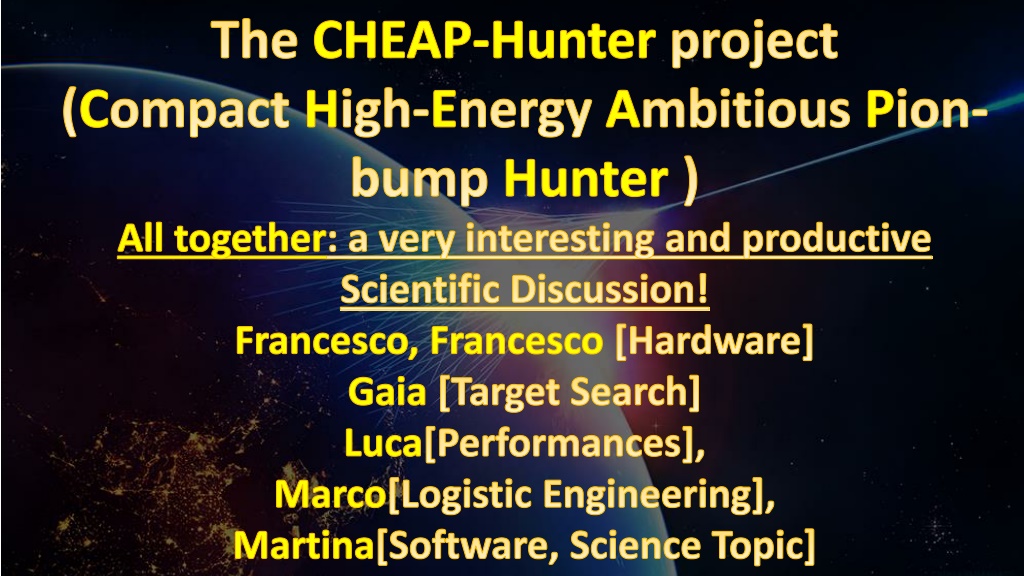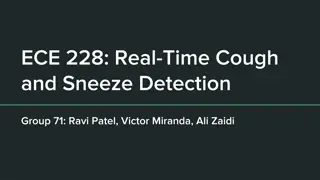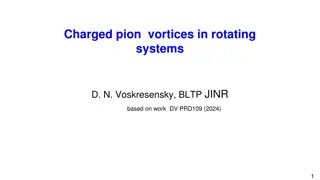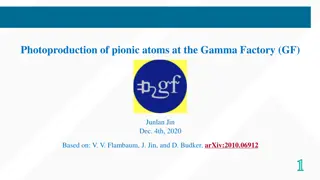The CHEAP-Hunter Project: Exploring Pion-Bump Detection in High-Energy Science
The CHEAP-Hunter project focuses on detecting pion bumps in the energy range of 1 MeV to 1 GeV, utilizing specialized equipment for improved sensitivity and accuracy. With a compact and efficient design, the project aims to enhance scientific understanding and observation capabilities in cosmic ray research. Key components include silicon trackers, CsI calorimeters, and anti-coincidence systems, all integrated into a lightweight and cost-effective detection system suitable for space deployment. The project's physical parameters, mission objectives, and operational details are meticulously planned to ensure successful data collection and analysis.
Download Presentation

Please find below an Image/Link to download the presentation.
The content on the website is provided AS IS for your information and personal use only. It may not be sold, licensed, or shared on other websites without obtaining consent from the author. Download presentation by click this link. If you encounter any issues during the download, it is possible that the publisher has removed the file from their server.
E N D
Presentation Transcript
The CHEAP-Hunter project (Compact High-Energy Ambitious Pion- bump Hunter ) All together: a very interesting and productive Scientific Discussion! Francesco, Francesco [Hardware] Gaia [Target Search] Luca[Performances], Marco[Logistic Engineering], Martina[Software, Science Topic]
PION BUMP DETECTION (Kelner06, Giuliani11, Ackermann13, Cardillo14 ) Ackermann Ackermann et al. (2013) et al. (2013) W44 W51c Giuliani,Cardillo Cardillo et al. 2014 Giuliani,Cardillo et al. 2011 Cardillo et al. 2014 et al. 2011 Jogler Jogler et al. 2016 et al. 2016 W44 67,5 MeV Importance of no detection: Confirmation of the theoretical model predicting low-energy CR exclusion from clouds (Gabici16)
Energy range: 1 MeV 1 GeV we want focus our mission on the "pion- bump" feature research Only-Silicon microstrip double-layer tracker for direction end energy reconstruction: Compton effect (E~<10 MeV) and pair production Imaging low-energy photons and avoid the background due to Compton Scattering Radiation Length: 0,5 X0 Calorimeter Caesium Iodide (CsI) pixels Radiation Length: 1,3 X0 Anti-Coincidence System and time of flight: Particle rejection efficiency >95 % Sensitivity: 7,85 x 10-8 ph/cm2/s [30-100 MeV, 1yr] Effective Area: 400 cm2 [constant] (Geometric Area*Efficiency(trigger, reconstruction, interaction) ) Angular Resolution and FoV to be estimated
IC443 W44 Tavani et al. 2010 Tavani et al. 2010 W51c Cardillo et al. 2014 Cardillo et al. 2014 Abdo et al 2009 Abdo et al 2009 Fluxes (30-100 MeV)[ph/cm2/s] Sources W44 1e-6 IC443 5e-7 W51c 4e-7 RX J0852.0-4622 2,8e-7 RX J1713,7-3946 2.2e-7 Cas A 5e-8
Physical parameter: 35 kg detector 24,5 cm x 24,5 cm x 28,2 cm 1mm between two Si slices of a single layer and 3mm between two layers Launcher: Kourou Vega [shared] cheap, small mission, at the Equator 250 kg: total weight [J. Wijker 2008], including margins Issues Industrial Cost Launch Support, ground Segment, Team Payload Contingency Budget [beginning + 1yr] 5 millions < 10 millions < 2 millions/yr Orbit: LEO (i < 10 ) between radiation belt and the densest atmosphere layer one revolution every 95 minutes Ground segment: Kourou telemetry (up/down link, S band) 10 minutes every 95 minutes (LEO) data (down link, X band) < 3 millions < 3 millions/yr 23 millions Power: triple junction in solar panel (1,6m2 total, (400 +/- 10%) Watt) battery capacity (Li Ion) = 500 W/h ESA call for small Missions (< 50 million )
Instrument Response Function in fits format: PSF (r68% or Gaussian) Effective Area Dispersion Energy Background MeV diffuse emission model (Ajello 2016) Kalman-Filter recoursive algorithm (Giuliani 2006) fundamental for the albedo photon rejection Maximum Likelihood analysis (Mattox 1996) optimized for extended sources Flux, coordinates and spectral index (several spectral assumptions: power law w HE cut-off, log-parabola )
Every estimation is very raw due to the limited time possible performance and target selection improvement A "hot" scientific topic SNRs a detection of "pion bump" can finally confirm the CR origin from A very cheap payload for a brief "life time" (with possible time extension) Possibility of analysis of other kind of gamma-ray sources























